The problem I find with this blog is that there is so much to discover and learn, each post really needs much more investigation than I currently have the time to do. This week’s post is an example.
My father took the following photo of a milestone in Highgate in 1948. It is just south of the Flask pub along Highgate West Hill. (For a view of the Flask and Highgate in 1948 see my post here.)
The milestone is still there. See my following photo of the milestone today. Nothing special you might think, but compare the mileage, five in 1948 and four today and the destination is a location that does not now exist in London, Saint Giles Pound.
So where and what was Saint Giles Pound?
Saint Giles refers to the parish of St. Giles in the Fields, the parish that took in the area around the church of the same name, just a short distance south-east from the junction of Tottenham Court Road, Oxford Street and Charing Cross Road.
In my usual London reference books I have found a number of references to the Saint Giles Pound which was a fenced area to hold sheep and cattle etc.
From “The History of the United Parishes of St. Giles in the Fields” by Rowland Dobie, published in 1829:
“The Pound and Cage originally adjoined each other, and stood in the middle of the High Street, from whence Parton informs us it was removed in 1656, to make way for the almshouses which were afterwards built there.
‘The Pound’ he adds, probably existed from a very early period, as a necessary appendage to the parish while a village, and abounding in pasture lands, though it is unnoticed in the books of the parish, till Lord Southampton’s grant of the ground on which it stood for the almshouses, where it is described as occupying a space of 30-feet, which was to the dimensions of the new Pound, therein directed to be removed to the end of Tottenham Court Road. The exact site of the Pound was the broad space where St. Giles High Street, Tottenham Court Road, and Oxford Street meet, where it stood till within memory. Noticed for the profligacy of its inhabitants, the vicinity of this spot became proverbial: witness the couplet of an old song.
‘At Newgate steps Jack Chance was found,
And bred up near St. Giles Pound’
it was finally removed about the year 1765, since when the neighbourhood has experienced many improvements, particularly by the erection of the great Brewery of Messrs. Meux and Co.
The Cage appears to have been used as a prison, not merely of a temporary kind, but judging from the parish records, with little lenity.”
Charles Knight in the Milestones section of his book, London, published in 1841 states:
“Again, St. Giles Pound, a real pound for cattle, which is marked upon the old plans, was a prominent object, standing in the village of St. Giles at the intersection of the roads from Hampstead and from Oxford. This also was something like the beginning of London: but Hicks’s Hall and St. Giles Pound have long since vanished; and the milestones which record their glory ought also to be swept away.”
The milestone therefore is alongside one of the old routes that was used to bring animals in from the north, through Highgate and down into London, and thankfully it has not been “swept away”.
The two photos of the milestones also have different distances, five in 1948 and four in 2016. The only reference I can find to this change is that it was made by a local resident of Highgate who was frustrated with the error. So is four miles correct? Although I have walked the route, I have not measured, so a quick check on Google maps, from Highgate West Hill at roughly the position of the milestone, to a point on New Oxford Street a very short distance past the end of Tottenham Court Road to allow for the possible siting of the Pound more towards St. Giles High Street. The following map confirms the distance as being exactly four miles (the blue dots). Even with some longer alternative routes, the distance does not reach five miles.
It would be interesting to know if the error in distance was from when the milestone was originally installed, or perhaps when the figures may have been re-cut as they do look very sharp in the 1948 photo with very little deterioration to the edge of the lettering. The key point is that today, the distance is correct.
A wider view of the milestone alongside Highgate West Hill.
Intriguingly, the Pound may be marked on a map. The following is an extract from John Rocque’s map of London from 1746. This is 19 years before the Pound was removed. Look in the lower right of the map, at the junction of Tottenham Court Road, Oxford Street and the High Street of St. Giles. There is a rectangular feature in the open area of the junction – could this be the Pound? The location fits perfectly the description given by Rowland Dobie in his book, quoted earlier.
Strange to think that this very busy junction, with the new Crossrail station being built, was once the location of a Pound, holding animals being brought down from the north.
The map extract is from the very lower right hand corner of the page. At the very bottom right corner is a street with only the word “Street” showing. This is Denmark Street featured in my post of a couple of weeks ago.
The map has some other references that point to the original use of this area. In the above map, the road running south from the junction is Hog Lane. The alley leading off from the top right of Hog Lane is Farmers Alley.
Hog Lane is now the northern section of Charing Cross Road. From “London” by George H. Cunnigham (1927):
“In Hogarth’s time this portion of the street was known as Hog Lane, later Crown Street, under which name it was widened and made part of Charing Cross Road.”
So after the Pound had disappeared, there was no longer an association with animals so the name changed, with finally as so often happens in London, the street being integrated in the lengthening and widening of a main street.
Returning to my opening comment at the start of today’s post, just finding this single milestone opens up so many questions.
Is there more information on the Pound, and is the original location marked on any maps? (the Rocque map shows the location after the move from St. Giles High Street). Are there any more of the milestones? I have not found any, however Knight’s book refers to another milestone in Camden at the two-mile point. What was the purpose of the Pound? Was it used as a stopping off point before heading into the City or did it serve the local area?
More questions for my ever-growing list of things to learn about London.

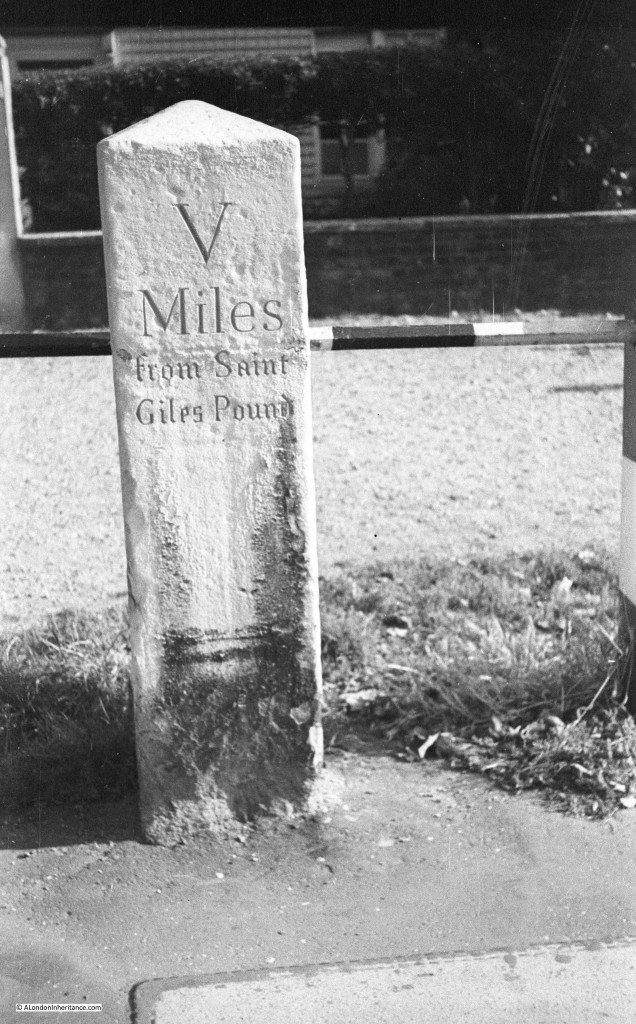
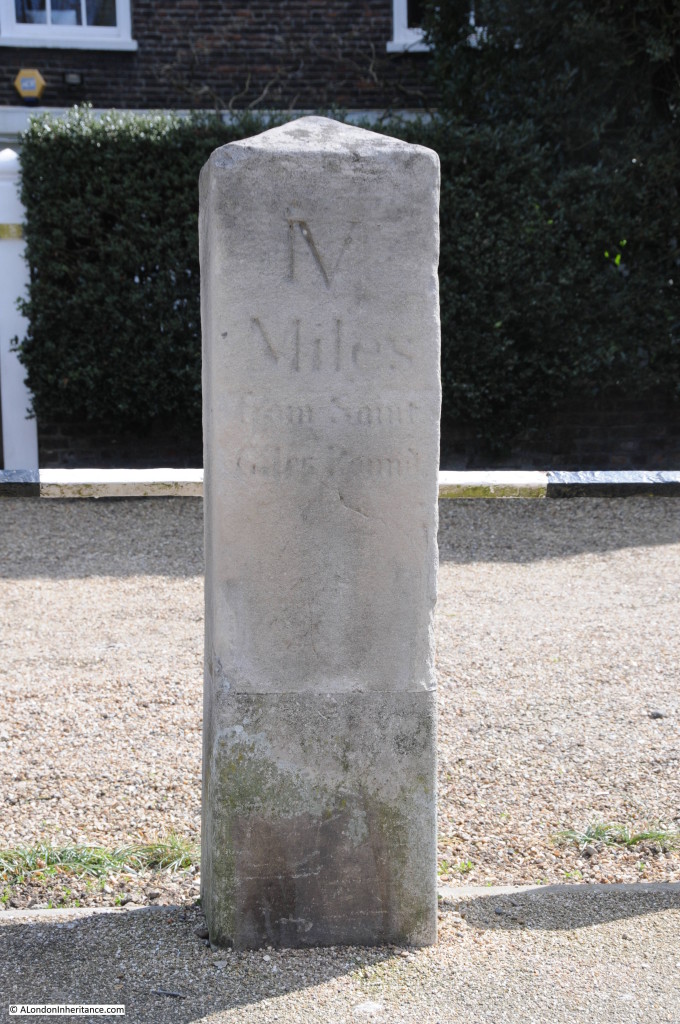
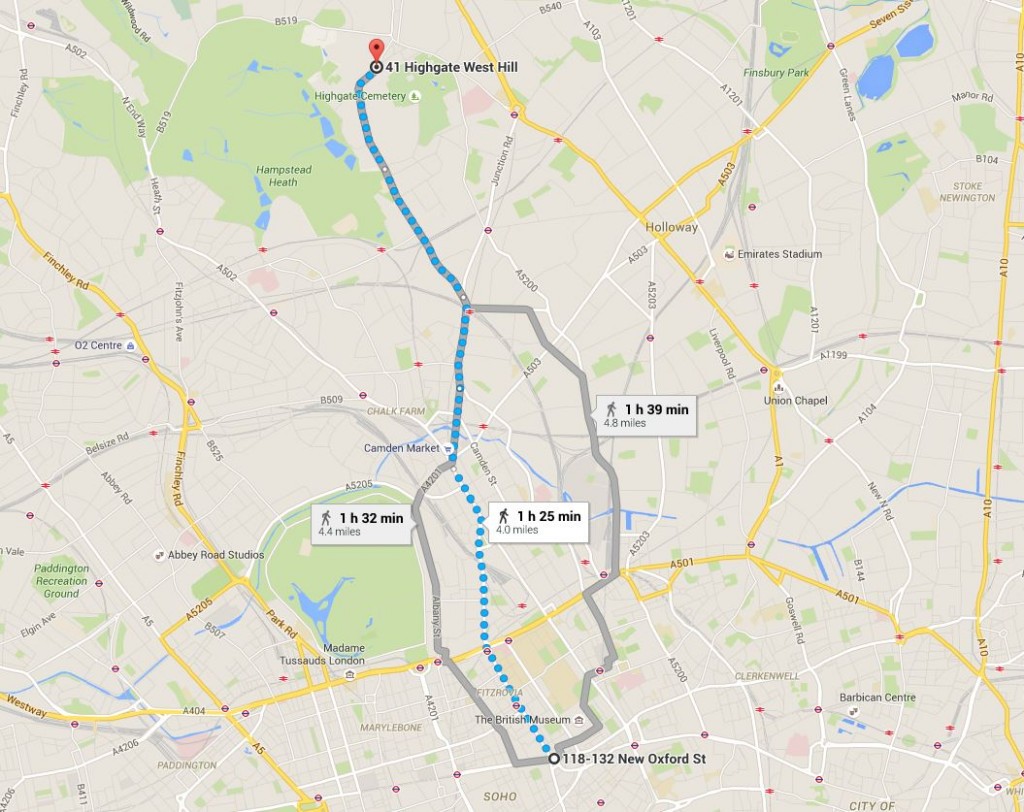
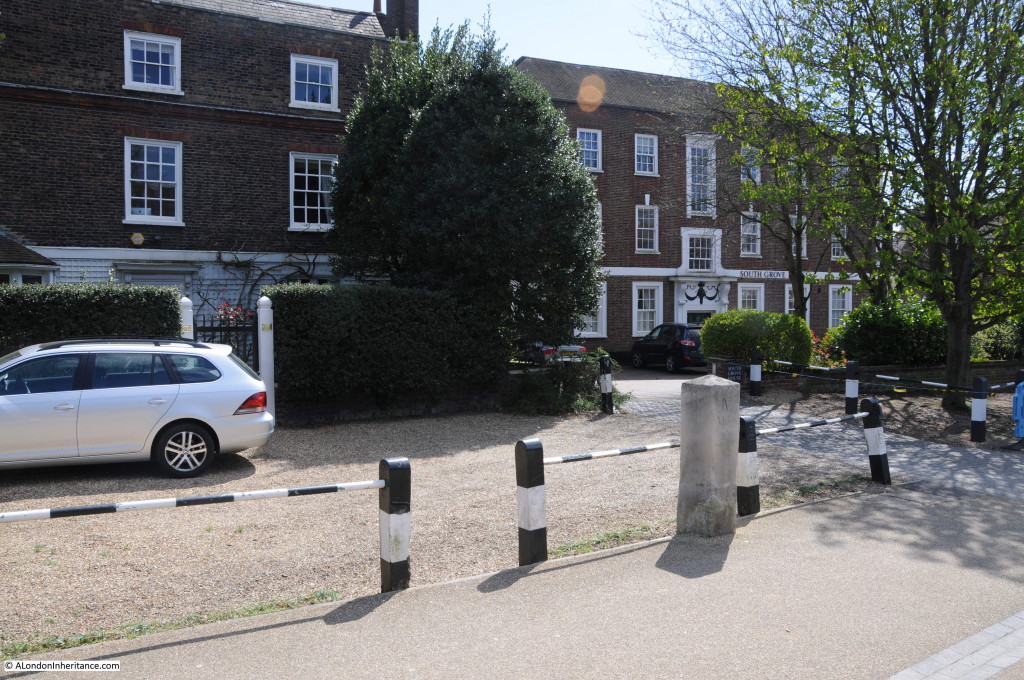
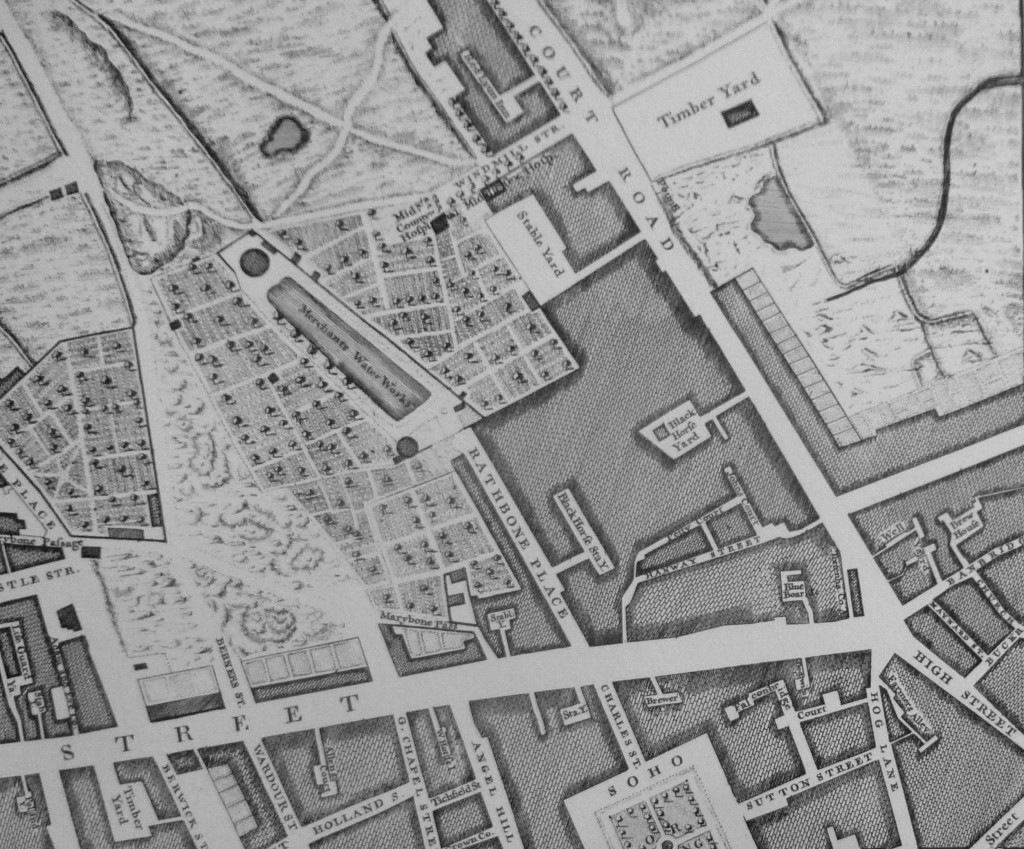
No possibility that the usage or ownership of some intervening land along your current best route really did originally enforce the longer 5-mile journey?
Hi Ian, yes, I also wondered whether this was the reason.The alternate routes on Google are all less than 5 miles so it must have been a reasonably large change of route, although the figure may have been rounded up, or it may have just been inaccuracy in the method of measurement at the time. I suspect we will never really know for sure.
Good stuff as ever.
I’ve found a couple of newspaper cuttings about the Pound. One, from 1837, notes that the Duke of Grafton’s estate extends from St Gile’s Pound up as far as Highgate. Perhaps, then, the milestones were commissioned by the Duke across his land. A second cutting, from 1720, concerns a wager in which an unnamed Earl managed to walk from St Giles Pound to the Flask (the one in Hampstead this time) in an hour.
I’m not sure I have your email address, and I can’t upload images here, so if you’d like to see them, email me on matt@londonist.com.
Cheerio,
M@
There is another mile stone in Hampstead by Whitestone Pond ( the reason for its name). Its says on one side IV miles from St Giles Pound and on the other 41/2 miles from Holborn bars.
The late Christopher Wade in Hampstead Past also says the pound was near to where Centre Point is today.
Marilyn
Pingback: London News Roundup: Thousands Protest Over Austerity | UnilagMusic UK
Thank you for these interesting posts. It’s a long shot, but a Roman mile was shorter than the standard mile we use today – 1620 yards vs 1760 yds. Perhaps that made it V miles away rather than IV?
Meux Brewery was the site in 1814 of the infamous London Beer Flood – http://www.historic-uk.com/HistoryUK/HistoryofBritain/The-London-Beer-Flood-of-1814/
Good bit of detective work. So glad they didn’t sweep the milestone away. Those Victorians and their desire to do away with the old.
Thanks Annie – Pleased that this milestone survived but I suspect many others were not so lucky. There was one recorded in Camden at the 2 mile point which I do not beleive is there anymore.
Living as I have for the last 46 years in Cape Town, it was of great interest to read of the Saint Giles Pound and also the Chalybeate Well. My last U.K. residence was in Rosslyn Hill, Hampstead and the Flask in particular (one of my local Haunts).
Any posts on North London will be greatly appreciated
Hi David – thanks for the comment. I do have lots more of north London and Hampstead which I plan to publish over the coming months which I hope you will find of interest.
If you look at the junction on Earth view on Google maps https://www.google.co.uk/maps/search/holborn/@51.5167836,-0.1306933,178m/data=!3m1!1e3 it’s clear that Tottenham Court Road widens at the southern end — so clearly could accommodate the potential site of the pound on the Rocque map. The TCR carriageway has been slewed to the west, to align with Charing Cross Road, so the actual site has been covered with the road (and I must admit I have never noticed the widening when I’ve been there).
Why is there a pound? Maybe to marshal the flocks that were on their way to Smithfield?
William Morgan’s map of 1682 shows the pound to have been right in the centre of what was then a ‘T’ junction, St Giles High St continuing north as Tottenham Ct Rd. Not quite (but only by yards) where you conjecture. I have not identified exactly where its earlier position had been. At that date it was located at the fringe of the built up area.
I have investigated these mileposts myself (see: http://www.metadyne.co.uk/n-milestones.html ). As far as I can see, there are only two survivors in this particular run, the 4MP (the subject of your item) and another half a mile to the south, immediately south of Langbourne Avenue, stating 3½ miles to St Giles Pound. However, there is another milestone in West Hill claiming 5 miles to the Post Office (then in Lombard St) which seems to be part of a different run that overlaps. Milestones usually correctly shown on OS maps but I can find no trace of any at 2 miles from the pound, but it ought to have been located in Kentish Town (Road) immediately south of Clarence Way.
On a happier note, the stones from St Giles pound towards Hampstead have fared better. The 3½, 4, 7, 8, 9, 10 and 11 mile stones are still in place, and the 5 mile stone is preserved (albeit most unsatisfactorily). I have posted images on above link.
I can send copy of St Giles plan (from a London Topographical Society map reprint) but cannot see a means on your system to let me do this.
The Pound was the rectangular shape on Rocque’s map near the junction of Tottenham Court Road. On 1 November 1717, a man named John Tripuck was whipped from Holburn Bars (which is shown on Rocque’s map) to the St. Giles’s Pound after being found guilty of wounding a constable.
Fascinating post – thank you !
St Giles Pound stood at the junction of two major routes – one from the north and the other (Uxbridge Road becoming Oxford Street) from the west along which drovers brought cattle and sheep to the Monday livestock Market at Smithfield until it was closed down In the 1850’s. A pound was used to hold animals which had broken free or simply roamed free until their owners reclaimed them. The name comes from “compound” , not the amount charged to reclaim which was nearer six old pennies.
The rectangular block on Rocque’s map is almost certainly the old St Giles cattle pound.
The Standard Water Pump at Cornhill , Tyburn and St Giles Pound were all used as fixed points from which to measure distances – each mile – from London, along major routes into and out of the capital. Very important especially when the turnpike roads were developed for stage coaches.
It’s incredible to think that beef was so important to London – 250,000 cattle sold each year at Smithfield – that right up to the middle of the 19th century drovers and their animals had right of way along even the most fashionable streets in the capital. When the beasts broke free there was carnage – the origin of the phrase Bull in a China Shop!
The pound became less important when the New Road was built in the 1770’s taking many cattle bound for Smithfield away from the centre of London , along what is now Sussex Gardens, Marylebone Road , Euston Road, Pentonville Road up to the Angel and down St John’s Street to Smithfield.
Yes, your milestone definitely looks recut. Some I’ve seen on the Uxbridge Road simply say “London”
Thanks again!